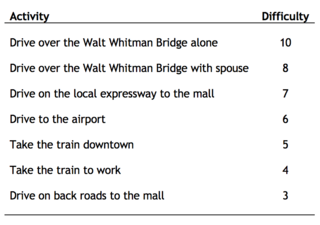Fear
Follow These Four Principles to Conquer Your Fear
Exposure therapy is the best-tested way to relieve excessive anxiety.
Posted March 20, 2018 Reviewed by Abigail Fagan

Anxiety disorders are the most common psychiatric conditions, with as many as one in four people affected during their lifetime. Anxiety can manifest itself in many ways:
- Being gripped by panic on a bridge or in a crowded restaurant
- The grinding worry of generalized anxiety
- Preoccupation with the judgment of others in social anxiety
- Terrifying memories following a traumatic event
- The repetitive, irrational fears of obsessive-compulsive disorder (OCD)
- Fear of specific things or situations in phobias
Each of these conditions can severely limit one's freedom, eventually leading to a life that's dominated by efforts to avoid what one fears.
We've all heard the maxim to "face your fears"—easier said than done, right? Most people know that running from our fears only makes them worse, and yet it's really hard to override our habit of moving away from what scares us.
Fortunately there is a well-tested way to push back on our fears and open ourselves up to life again. The approach is called "exposure therapy" because we expose ourselves to what we're afraid of, and is a type of cognitive behavioral therapy (CBT). It was developed over the past few decades and is the most effective way we know of to face our fears.
What Happens When We Face Our Fears?
The good news is that by confronting what scares us, over time we become less afraid. This basic process is built into the way animals' nervous systems work, from very basic organisms through the most complex, including humans.
This fact makes sense when we consider the opportunity cost of fear and avoidance. Anxiety restricts our actions, interfering with things like gathering food, finding water, looking for a mate, and other activities that require exploratory behavior. Excessive efforts to stay safe can lead paradoxically to giving up the fundamental activities of living.
So just as it's important for animals to know when to be afraid, they also need a way to determine when not to be afraid. By providing our nervous systems with the right information, we can break the cycle of fear and avoidance. Let's consider the best ways to provide that information.
Four Principles of Effective Exposure Therapy
It's hard to know exactly how to proceed based on a general principle like "face your fears." We may agree with the concept and have the motivation to do it, and be at a loss for how to get started.
The structure of CBT provides a powerful way to move toward your goals, as I wrote about in one of my earliest blog posts (Why Does Cognitive Behavioral Therapy Work?). Keep these principles in mind when facing your fears.
1. Do It on Purpose
We often come into contact incidentally with the things that scare us. We might be forced to drive on a terrifying stretch of highway, for example, or encounter something that looks like blood if we have an obsessive fear of bodily fluids. These confrontations in and of themselves are triggering but not therapeutic.
In contrast, exposure is done deliberately. We intentionally defy our desire to avoid, which might include choosing to drive on the more challenging bridges, or going to a party precisely because we know it will make us anxious.
When we move, on purpose, toward what we're afraid of, our nervous system receives new information that's incongruent with fear (which usually leads to moving away). This incongruence sends a powerful message to our brains that maybe our fear isn't necessary.
2. Follow a Plan
In exposure therapy we create a series of steps to help us gradually face our fears, which we call an "exposure hierarchy." I often compare it to climbing a ladder, with more approachable situations on the lower rungs and the higher rungs being progressively more challenging. When we first start an exposure program it may be impossible to imagine ourselves doing the highest items on our list, and that's OK; as we climb the ladder, the top will gradually become reachable.
Start by making a list of activities you could do that would trigger your fear. Be as creative and comprehensive as possible, looking for multiple ways to challenge yourself. Next, rate the difficulty of each activity from 0-10 (10 being the hardest).
Remember to aim for a range of difficulty levels, with no huge gaps in your hierarchy. This might require tweaking activities in some way to raise or lower the difficulty. For example, if driving over a bridge alone is a big step up from the activity below it, driving over it with someone in the car could provide an intermediate step.

I've provided an example of an exposure hierarchy for "Jon," a hypothetical person with a panic-related fear of driving and public transportation.
3. Stay Through Your Discomfort
When we approach the things we fear, it's going to feel uncomfortable. A crucial part of exposure is staying in the situation despite that discomfort; if we run away, we'll only be reinforcing our fear and avoidance.
Therefore it's important to choose items from the hierarchy that you expect to be manageable. Sometimes we might be tempted to jump right to the top to "get things over with," but then we may end up fleeing when we feel overwhelmed. Aim instead for an appropriately challenging activity—one that's difficult but doable.
When you plan your activity, decide in advance what the specifics will be—for example, how long you'll pet a feared animal, how many trips you'll take in the elevator, or how far you'll take the train.
Your anxiety might go down while you're doing the exposure exercise, or it might not; research has shown that in the long run, exposure is effective either way. So even if you're just as afraid at the end of your exposure as at the beginning, you'll probably feel less afraid the next time you do it—which brings us to the fourth and final point.
4. Repeat as Needed
Doing something we're afraid of one time is an act of courage, but by itself is not therapeutic. We conquer our fears by repeating the activities until the fear diminishes.
This principle makes sense if we think about times we've done something dangerous but were unhurt (e.g., that time I swam across a river in the middle of the night). We would be unlikely to pass on our genes if doing something scary one time completely eliminated our fear.
You also should plan to repeat your activities relatively close together in time, which gives our nervous system a large enough "dose" of exposure to learn what it needs to. On the other hand, do give yourself some time in between exposures for the new learning to settle in and to avoid overwhelming yourself. Doing exposures once per day is a good guideline, perhaps taking a day off each week.
Questions or comments? Please leave them below. I wish you all the best as you face your fears and reclaim a fuller life.
References
Gillihan, S. J., & Foa, E. B. (2016). Exposure-based interventions for adult anxiety disorders, obsessive-compulsive disorder, and posttraumatic stress disorder. In A. M. Nezu & C. M. Nezu (Eds.), Oxford handbook of cognitive and behavioral therapies (pp. 96-117). Oxford, UK: Oxford University Press.




